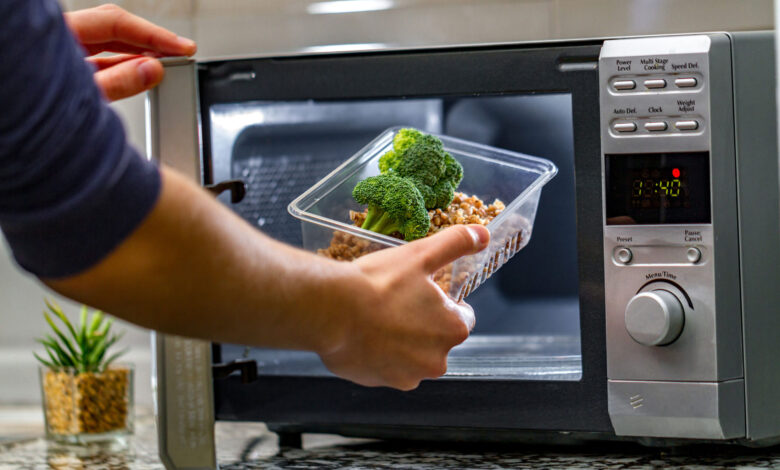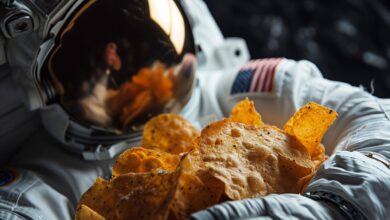
Plastics are usually found in refrigerators and cabinets in all homes. Plastic wrap, food storage bags and containers, plastic takeout containers, beverage bottles, and sauce containers are all very common. Also, plastics, or synthetic polymers, are part of the multilayer materials that make up common food packaging, such as chip packets and mineral water bottles.
Even metal, steel and aluminum cans, like soda cans, are all covered with a layer of plastic. Paper products such as disposable takeout cups and frozen food packages are also covered with a layer of plastic.
But should we be worried about the plastics that surround the food? Are these materials safe? The answer to such a question depends on various factors, but according to experts, the fear of plastic is not something that can be ignored and there are ways to reduce its risks.
The staggering dangers of plastic exposure
For decades, scientists have known that some compounds in some plastics can penetrate into food from the packaging and be absorbed by the body. For example, the chemical compound bisphenol A (abbreviated BPA), which seeps into food from packaging and accumulates in the body of living organisms, including humans, has been known since the 1990s.
Studies have shown that bisphenol A can endanger human health by mimicking the behavior of the hormone estrogen. Joe Brownprofessor of epidemiology at Brown University’s School of Public Health, says that although there is controversy about the consequences of exposure to small amounts of BPA, new research shows that the substance can negatively affect behavior and cognition, especially in infants and children.
In response to research findings, the use of BPA has been stopped in some cases. For example, according to the regulations of the US Food and Drug Administration, the use of this substance in baby bottles is prohibited. However, BPA is still present in many food packaging, such as the lining of cans.
Studies have shown that even BPA alternatives may have the same risks. Such a pattern has been repeated many times in the history of environmental health and epidemiology; Harmful chemicals, such as pesticides or fire retardants, are replaced by alternatives that have not been tested and may be just as harmful. “Within the current regulatory framework, there’s not a lot of scrutiny on these new substances to determine if they’re harmful or not,” Brown says.
Chemicals in plastics cause premature birth, increased risk of asthma and neurodevelopmental abnormalities
In addition to BPA, the health and hygiene problems of other chemicals such as phthalates (and alternatives) used as plasticizers and to make plastics flexible are well known. These substances potentially cause problems including premature birth, increased risk of asthma and neurodevelopmental abnormalities. Persistent chemicals (PFAS), which have been linked to an increased risk of cancer, are also found as a byproduct of plastic manufacturing in food stored in plastic and in beverages.
The amount consumed is a key factor in assessing the risks of chemicals. Some compounds may be safe to consume in very small amounts, while consuming larger amounts may trigger illnesses. But it is very difficult to accurately determine the amount of problems caused by the specific compounds of any substance that is regularly consumed and enters the body through food and packaging.
Worryingly, we know so little about the chemicals in food packaging, while we unknowingly consume them every day. A comprehensive review in a new study published recently shows that more than 3,500 chemicals found in food packaging and processed materials enter the human body.
Jane Monkan environmental toxicologist and CEO of the nonprofit Food Packaging Association and lead author of the new study, says the majority of exposure to such compounds comes from food coming into contact with plastic. But other materials such as recycled paper and cardboard also contain many chemicals that enter food.
Although the new study doesn’t go into detail about the specific effects of each of these thousands of chemicals on our health, it does show that we are exposed to large amounts of such compounds in our daily diet. And yet, our knowledge of such concepts has many flaws. For example, the presence of oligomers, short-chain polymers, and accidental byproducts of plastic manufacturing are common in packaging and processed food materials. “We don’t really know anything about how toxic they are, and that’s a concern,” Munk says. Such data gaps should be investigated.”
Munk and Brown say that even studying derived compounds often doesn’t provide enough information because the truth is so complex. What enters the body is not just a chemical substance. Despite food packaging and the extent of contact, “we’re exposed to a soup of chemical compounds,” Brown says. We know that chemicals have less health effects than their components. So far, limited studies on the interactions of multiple chemical exposures suggest that such combinations can exacerbate each other and increase adverse effects.
It’s scary to think about the ways in which plastic enters the food chain and affects our health. However, completely eliminating plastic from the kitchen and everyday life can also become a full-time job. Instead of worrying, it is possible to reduce the risk of exposure to chemicals by taking practical measures.
The amount of heat, contact surface, contact time, and initial chemicals are all important factors to consider when choosing how to store food.
First, never heat food in the microwave with plastic containers. Martin Wagner“Higher temperatures accelerate the leaching of chemicals and the release of microplastics,” says a biologist at the Norwegian University of Science and Technology who is studying the effects of plastic on health. Also, Brown advises against storing hot foods, such as soups fresh off the stove, in plastic containers.
Never heat food in plastic containers in the microwave
Consider the amount of food contact with plastic. Liquids, powders and grains have more contact surface to absorb chemicals. According to Munk, single-use containers absorb more material than plastic, so use alternative liners when possible. Also, storing food in plastic for several months is more worrisome than short-term storage of a few days in the refrigerator. Non-perishable and original food items such as flour, rice and cooking liquids are best stored in glass, stainless steel or ceramic containers for a long time.
Also, foods with high fat and acid can absorb more chemicals from storage containers. Oils, vinegars, cheeses, ketchup and sodas are more reactive and “can be agents of chemical extraction,” Munk says. It’s best to buy samples of these items that aren’t stored in plastic or plastic-lined cans.
In addition, Brown adds, making changes to food storage containers has two big benefits: reducing negative health risks from food exposure to chemicals, and reducing the amount of single-use plastic that ends up in landfills.
However, compromises are inevitable and plastics have their uses. For example, plastic wraps, although they may present health hazards, are usually one of the most effective methods for short-term storage to prevent food spoilage. Reducing food waste and costs are reasonable goals, and finding alternative storage methods with high flexibility and efficient performance of plastics may be more difficult.
Glass, ceramic, and stainless steel containers are reusable and chemically inert, so if you can fit food in them, go for it. But you should be careful that not all kitchen products live up to their sustainability claims in the field of being reusable.
Finally, you don’t need to take any special steps to make big, beneficial changes. “The most important thing is not to drive yourself crazy,” Munch emphasizes. We can control parts of the risk of chemical exposure, but some are beyond our control. As a consumer, only do what you can.
In the long term, a comprehensive solution to the dangers posed by plastic packaging should be achieved through new policies. Currently, food packaging follows a “safe until proven guilty” approach. In other words, companies use chemicals in packaging and we find out later whether these chemicals are harmful or not. Unlike drugs, which must undergo rigorous safety testing before being approved for use, food packaging is not as scrutinized. “I believe the overall paradigm needs to change,” Brown says.









